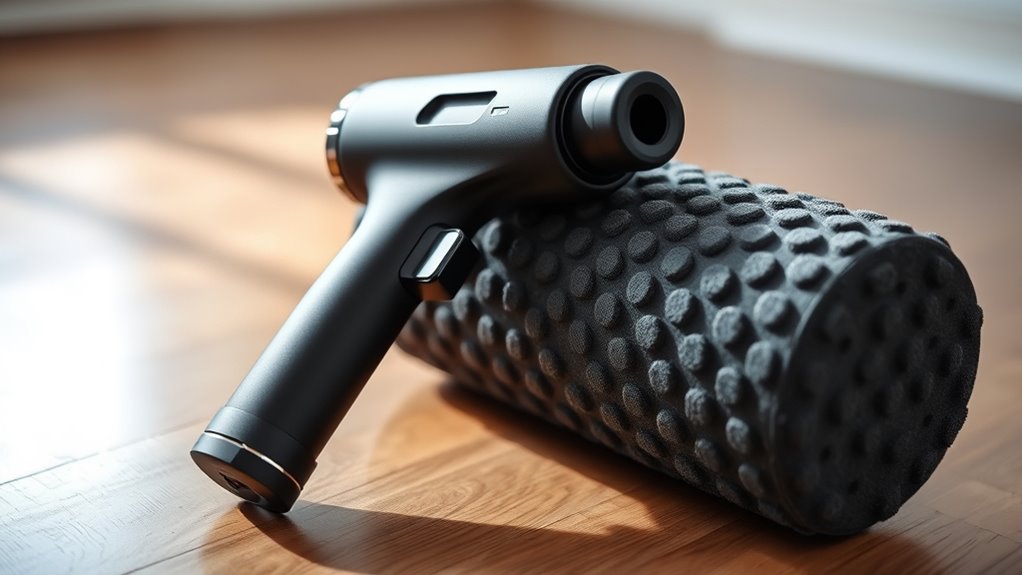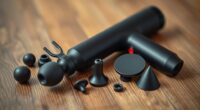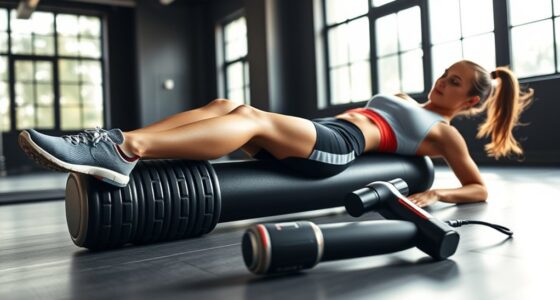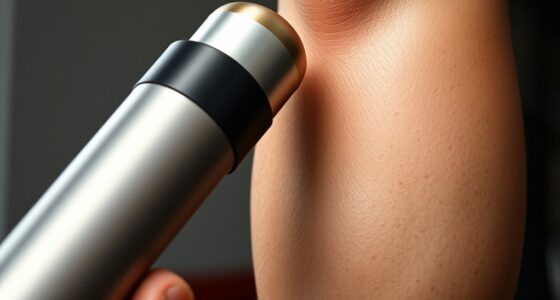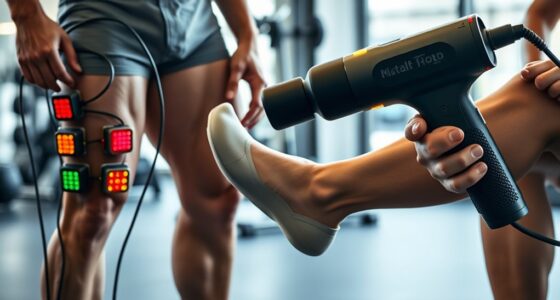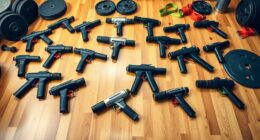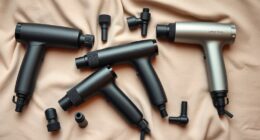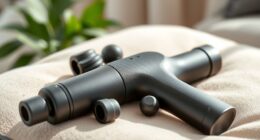Choosing between a massage gun and a foam roller depends on your recovery goals and activity level. Massage guns deliver rapid pulses to target deep tissues quickly, making them ideal for focused relief and fast recovery. Foam rollers use sustained pressure to stretch muscles and release adhesions, perfect for larger muscle groups and longer sessions. Both are effective if used correctly, so exploring their benefits further can help you make the best choice for your needs.
Key Takeaways
- Both tools effectively reduce muscle soreness and promote recovery, but their mechanisms differ: percussion versus sustained pressure.
- Massage guns provide rapid, targeted pulses ideal for deep tissue relief, while foam rollers offer broader, sustained muscle elongation.
- Proper technique and caution are essential to avoid injury; avoid use on injured, inflamed, or bony areas.
- Choice depends on activity type, muscle group, and personal preference; high-intensity athletes may prefer massage guns.
- Consider cost, portability, and usage environment to determine which tool best supports your recovery routine.
How Do Massage Guns and Foam Rollers Work? The Science Behind Their Mechanisms
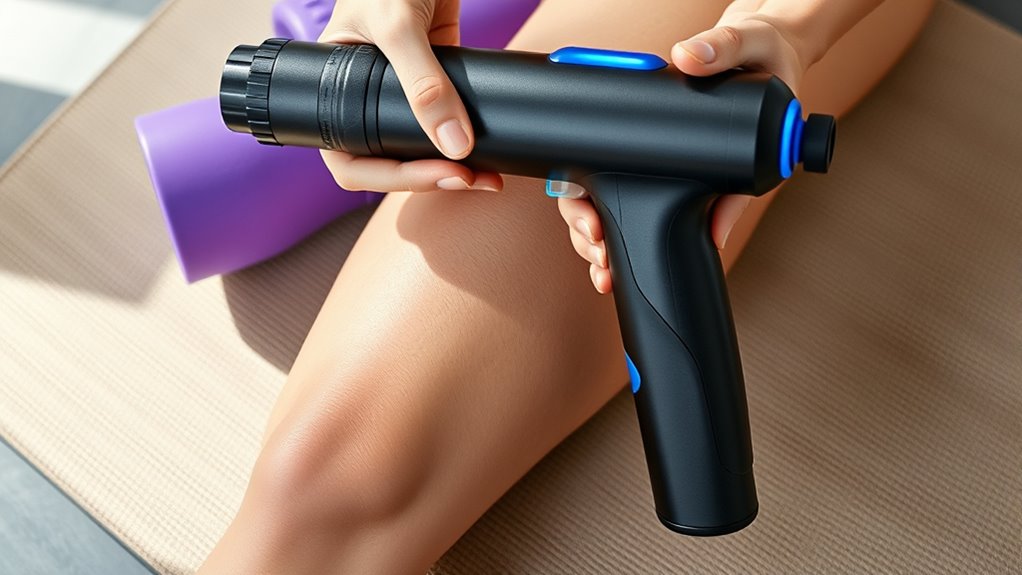
Massage guns and foam rollers work by applying targeted pressure to your muscles, but they do so through different mechanisms. Massage guns deliver rapid percussive pulses that stimulate muscle tissue directly, promoting muscle stimulation and increasing blood flow. This action helps loosen tight muscles and reduce tension. Foam rollers, on the other hand, use sustained pressure and body weight to compress tissues, encouraging tissue elongation and breaking up adhesions within muscle fibers. As you roll, you manually apply pressure that stretches muscle tissue, enhancing flexibility and reducing knots. Both tools aim to improve muscle health, but they achieve this through distinct processes—massage guns via rapid pulses for stimulation, foam rollers through sustained pressure for tissue elongation. Understanding these mechanisms helps you choose the right tool for your needs. Additionally, awareness of muscle physiology can enhance your effectiveness when using either tool.
Effectiveness in Muscle Recovery and Soreness Relief
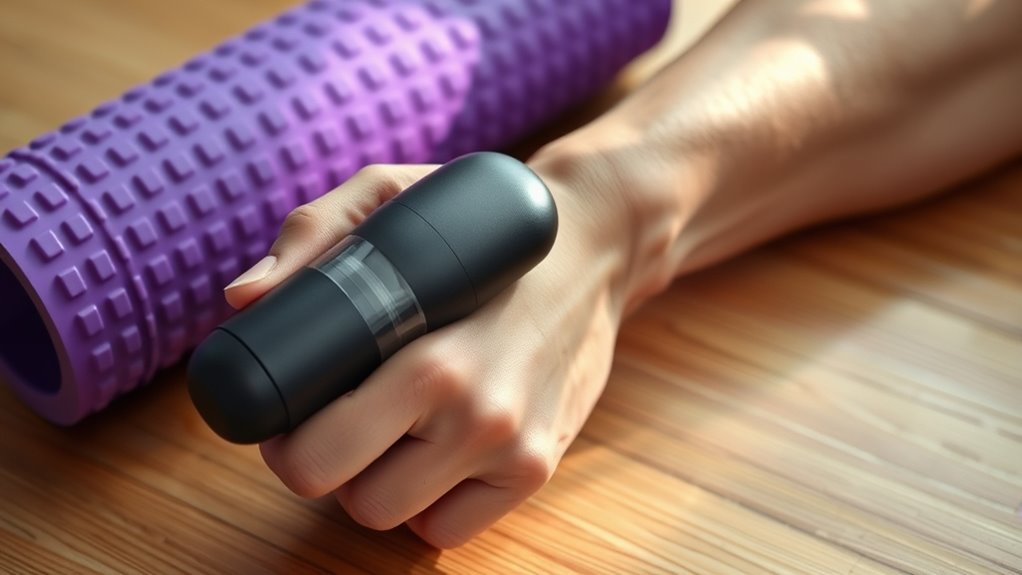
Both massage guns and foam rollers can effectively reduce muscle soreness and speed up recovery, but their results often depend on how you use them. Trigger point therapy with these tools targets specific knots or tight areas, relieving muscle tension more effectively. Foam rollers excel at broad, sustained pressure to loosen larger muscle groups, while massage guns deliver rapid, focused pulses to break up tightness. Using either method regularly can decrease soreness after workouts and improve circulation, helping muscles recover faster. Additionally, proper technique ensures you maximize the benefits and minimize the risk of injury. However, your choice depends on your needs: foam rollers are great for overall muscle tension relief, whereas massage guns are better for pinpoint trigger points. Consistent use guarantees you experience better muscle recovery and less soreness over time.
Safety, Risks, and Considerations for Use
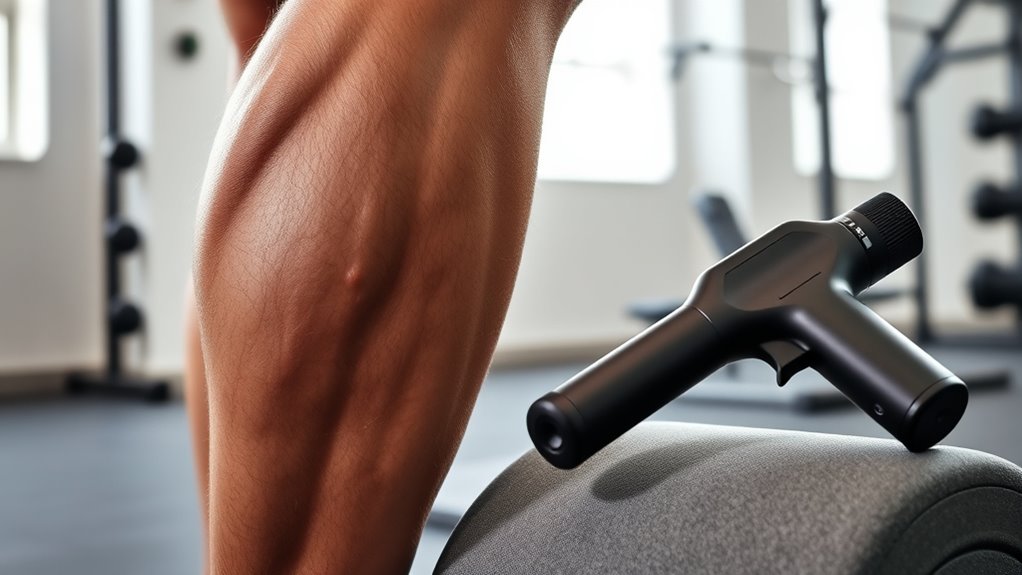
While massage guns and foam rollers are effective tools for muscle recovery, it’s important to be aware of potential risks and safety considerations. Using these tools improperly can lead to injury or discomfort, affecting your overall user experience. To promote injury prevention, avoid applying excessive pressure or targeting areas with injuries or inflammation. Always listen to your body, and stop if you feel sharp pain. Be cautious around bony areas and vulnerable spots like joints or the neck. Proper filtration and maintenance can also help prevent issues related to equipment malfunction.
Which Tool Is Better for Different Types of Athletes and Activities

Choosing the right recovery tool depends on your sport, activity level, and specific needs. For athlete specialization, a foam roller might suit endurance athletes or those focusing on flexibility, as it helps release muscle tightness and improve range of motion. Conversely, a massage gun can be more effective for athletes involved in high-intensity activities requiring quick recovery, as its percussive action targets deep tissues rapidly. The activity’s intensity also influences your choice: if you experience frequent soreness from vigorous workouts, a massage gun’s targeted deep tissue treatment can provide faster relief. On the other hand, foam rollers are ideal for regular maintenance and longer sessions focusing on muscle relaxation. Additionally, incorporating Kia Tuning modifications such as suspension upgrades can help optimize overall body mechanics, which may indirectly support recovery processes. Ultimately, selecting the right tool depends on understanding your sport’s demands and how your body responds to different recovery methods.
Making an Informed Choice: Factors to Consider When Choosing Between a Massage Gun and Foam Roller

Selecting the right recovery tool requires evaluating your specific needs, workout habits, and personal preferences. Start by considering the cost comparison—massage guns tend to be more expensive upfront, but they offer versatile features and durability. Foam rollers are generally more budget-friendly and require no batteries or charging. Portability considerations are also key; foam rollers are lightweight and simple to carry, making them ideal for on-the-go use or travel. Massage guns, while compact, may be bulkier and heavier, which could influence your decision if you need a tool you can take anywhere. Think about how often you’ll use the device, your budget, and where you’ll use it most. This assessment helps you choose the tool that best supports your recovery routine. Additionally, evaluating the vacuum options for your cleaning needs can help you maintain a healthier living environment, especially if allergies are a concern.
Frequently Asked Questions
Can Massage Guns or Foam Rollers Prevent Injuries?
Using massage guns or foam rollers can promote muscle relaxation, which helps reduce stiffness and tightness. This may aid in injury prevention by keeping your muscles flexible and less prone to strains. Regular use supports your recovery and maintains muscle health, lowering the chance of injuries. While they don’t guarantee injury prevention, incorporating these tools into your routine can enhance muscle function and decrease your risk of future problems.
How Long Should I Use Each Tool per Session?
You might think longer sessions boost muscle recovery and pain relief, but research shows moderation is key. Use a massage gun or foam roller for about 1-2 minutes per muscle group, focusing on areas of tension. Excessive use can cause soreness or injury. Pay attention to how your body feels, and adjust your session length accordingly to optimize recovery without risking overuse.
Are There Specific Muscles Better Suited for Each Tool?
You should consider muscle targeting and tool specificity when choosing between a massage gun and a foam roller. Massage guns work best on smaller, tight muscles like calves or shoulders, providing deep tissue relief. Foam rollers are more effective for larger muscle groups such as quads or hamstrings, offering broad, sustained pressure. Matching the tool to your muscle’s size and needs guarantees effective recovery and relief.
Do These Tools Replace Professional Massage Therapy?
These tools don’t replace professional massage therapy, but they can support your muscle recovery and sports performance. Massage guns and foam rollers help reduce muscle tension, improve blood flow, and ease soreness, which can enhance recovery. However, a professional therapist offers tailored treatments for complex issues. Use these tools as complementary aids to optimize recovery, but don’t rely solely on them for extensive muscle care or injury management.
Can I Use Them Before or After Workouts?
You can definitely use a massage gun or foam roller before or after workouts. Using them pre-workout offers benefits like increased blood flow and muscle activation, helping you perform better. Post-workout, they aid in recovery by reducing soreness and tightness. Just make sure to use gentle pressure pre-workout and deeper, targeted sessions afterward. Incorporating them at the right times can enhance your overall workout experience.
Conclusion
Ultimately, choosing between a massage gun and foam roller depends on your needs and preferences. Scientific studies suggest both tools effectively reduce soreness and aid recovery, but your comfort matters most. Notably, some theories claim that vibration from massage guns might stimulate faster muscle healing, though more research is needed. So, try both, listen to your body, and select what feels best—your muscles will thank you for it!
